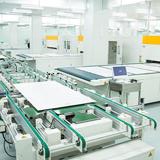

Screen printing ink also known as plastic ink, or adhesive ink. Applicable to 100% cotton, cotton/polyester blend, polyester, dark and light color cloth, denim and other fabrics, where the following two meet the fabric can be used: 1, 150°C; 2, have air permeability, can make the ink penetrate into. Not suitable for the substrate such as: plastic, metal, glass and waterproof treatment of nylon cloth. Xiaobian sorted out the six problems that are easy to appear in the operation process of screen printing ink manufacturers:
(1) the ink layer surface foaming, pattern is not smooth, ugly appearance: curing temperature is too high, too long; Heating tube and substrate is too close to the distance or hot air gun and printing pattern is too close to the distance, or curing temperature is too high, too slow; Adding diluents or auxiliaries incorrectly; The printing environment is poor, the dust is more than 0 knife notched or not straight, the screen is blocked or the printing table is not smooth.
(2) adhesion is not good, easy to fade: curing temperature is not enough, not fully cured; Although the curing temperature and time meet the requirements, but the power can not reach, so that the ink layer surface melting, the bottom can not reach the curing temperature, resulting in ink can not be completely cured (especially three-dimensional and thick printing); The selected printing materials can not meet the requirements of thermosetting ink printing.
(3) Dongguan screen printing ink seepage phenomenon: the temperature is not up to, not completely dry; The substrate can not meet the requirements of thermosetting ink printing (such as waterproof cloth, coated cloth, etc.), all the cloth without permeability is easy to produce the phenomenon of surface oil seepage; Ink diluent or additives added to excess.
(4) three-dimensional effect ink collapse: printing screen printing ink film is too thick; Printing ink scraping pressure is too large or uneven; Ink layer surface is not dry on the overprint; The curing temperature is too high, or the curing time is too long.
(5) color migration, discoloration: curing temperature is not enough, the ink layer is not fully cured; Disperse dyes are used in the printing substrate. When the printing cut pieces are heated to a certain temperature, the dyes in the cloth will sublimate, leading to color migration. The use of poor migration resistance of color ink for toning printing, such as purple, pink and fluorescent color; Ink curing temperature is too high, especially the fluorescent color or bright color of the ink, the general heat resistance is relatively poor, after high temperature curing pigment easily produce discoloration phenomenon.
(6) The surface of the printing pattern is not clear, and the words and lines are not fine: the production quality of the printing screen is poor (the pattern effect is not good, the tension of the two plates is not enough, or the printing equipment and technology are not good); Poor printing process (uneven ink scraping pressure during printing); Ink viscosity adjustment is improper; Printing substrate is too rough to meet the requirements of fine printing.
Tel:15158365810
HTML:www.mysyqc.com
Add:No.185, bridge 3 road, xiaoqiaotou village, qiaotou town, cixi city